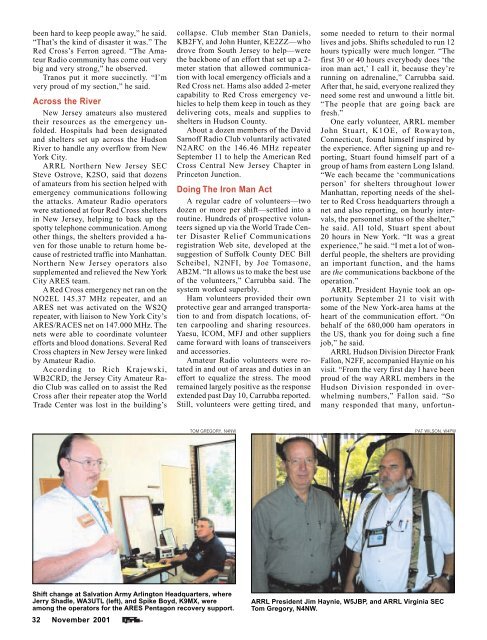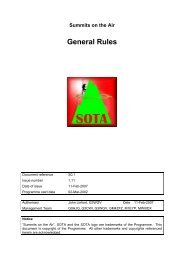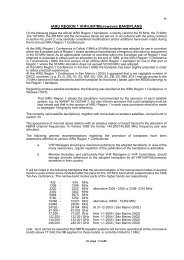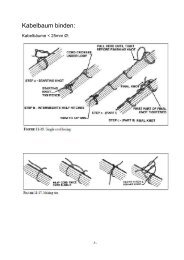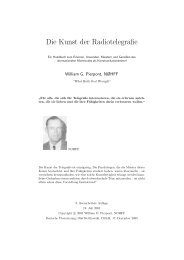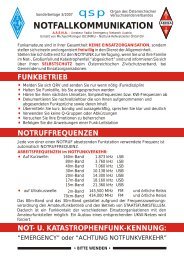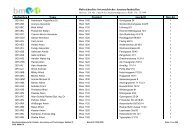World Trade Center and Pentagon terrorist attacks - ARRL
World Trade Center and Pentagon terrorist attacks - ARRL
World Trade Center and Pentagon terrorist attacks - ARRL
Create successful ePaper yourself
Turn your PDF publications into a flip-book with our unique Google optimized e-Paper software.
een hard to keep people away,” he said.<br />
“That’s the kind of disaster it was.” The<br />
Red Cross’s Ferron agreed. “The Amateur<br />
Radio community has come out very<br />
big <strong>and</strong> very strong,” he observed.<br />
Tranos put it more succinctly. “I’m<br />
very proud of my section,” he said.<br />
Across the River<br />
New Jersey amateurs also mustered<br />
their resources as the emergency unfolded.<br />
Hospitals had been designated<br />
<strong>and</strong> shelters set up across the Hudson<br />
River to h<strong>and</strong>le any overflow from New<br />
York City.<br />
<strong>ARRL</strong> Northern New Jersey SEC<br />
Steve Ostrove, K2SO, said that dozens<br />
of amateurs from his section helped with<br />
emergency communications following<br />
the <strong>attacks</strong>. Amateur Radio operators<br />
were stationed at four Red Cross shelters<br />
in New Jersey, helping to back up the<br />
spotty telephone communication. Among<br />
other things, the shelters provided a haven<br />
for those unable to return home because<br />
of restricted traffic into Manhattan.<br />
Northern New Jersey operators also<br />
supplemented <strong>and</strong> relieved the New York<br />
City ARES team.<br />
A Red Cross emergency net ran on the<br />
NO2EL 145.37 MHz repeater, <strong>and</strong> an<br />
ARES net was activated on the WS2Q<br />
repeater, with liaison to New York City’s<br />
ARES/RACES net on 147.000 MHz. The<br />
nets were able to coordinate volunteer<br />
efforts <strong>and</strong> blood donations. Several Red<br />
Cross chapters in New Jersey were linked<br />
by Amateur Radio.<br />
According to Rich Krajewski,<br />
WB2CRD, the Jersey City Amateur Radio<br />
Club was called on to assist the Red<br />
Cross after their repeater atop the <strong>World</strong><br />
<strong>Trade</strong> <strong>Center</strong> was lost in the building’s<br />
collapse. Club member Stan Daniels,<br />
KB2FY, <strong>and</strong> John Hunter, KE2ZZ—who<br />
drove from South Jersey to help—were<br />
the backbone of an effort that set up a 2-<br />
meter station that allowed communication<br />
with local emergency officials <strong>and</strong> a<br />
Red Cross net. Hams also added 2-meter<br />
capability to Red Cross emergency vehicles<br />
to help them keep in touch as they<br />
delivering cots, meals <strong>and</strong> supplies to<br />
shelters in Hudson County.<br />
About a dozen members of the David<br />
Sarnoff Radio Club voluntarily activated<br />
N2ARC on the 146.46 MHz repeater<br />
September 11 to help the American Red<br />
Cross Central New Jersey Chapter in<br />
Princeton Junction.<br />
Doing The Iron Man Act<br />
A regular cadre of volunteers—two<br />
dozen or more per shift—settled into a<br />
routine. Hundreds of prospective volunteers<br />
signed up via the <strong>World</strong> <strong>Trade</strong> <strong>Center</strong><br />
Disaster Relief Communications<br />
registration Web site, developed at the<br />
suggestion of Suffolk County DEC Bill<br />
Scheibel, N2NFI, by Joe Tomasone,<br />
AB2M. “It allows us to make the best use<br />
of the volunteers,” Carrubba said. The<br />
system worked superbly.<br />
Ham volunteers provided their own<br />
protective gear <strong>and</strong> arranged transportation<br />
to <strong>and</strong> from dispatch locations, often<br />
carpooling <strong>and</strong> sharing resources.<br />
Yaesu, ICOM, MFJ <strong>and</strong> other suppliers<br />
came forward with loans of transceivers<br />
<strong>and</strong> accessories.<br />
Amateur Radio volunteers were rotated<br />
in <strong>and</strong> out of areas <strong>and</strong> duties in an<br />
effort to equalize the stress. The mood<br />
remained largely positive as the response<br />
extended past Day 10, Carrubba reported.<br />
Still, volunteers were getting tired, <strong>and</strong><br />
some needed to return to their normal<br />
lives <strong>and</strong> jobs. Shifts scheduled to run 12<br />
hours typically were much longer. “The<br />
first 30 or 40 hours everybody does ‘the<br />
iron man act,’ I call it, because they’re<br />
running on adrenaline,” Carrubba said.<br />
After that, he said, everyone realized they<br />
need some rest <strong>and</strong> unwound a little bit.<br />
“The people that are going back are<br />
fresh.”<br />
One early volunteer, <strong>ARRL</strong> member<br />
John Stuart, K1OE, of Rowayton,<br />
Connecticut, found himself inspired by<br />
the experience. After signing up <strong>and</strong> reporting,<br />
Stuart found himself part of a<br />
group of hams from eastern Long Isl<strong>and</strong>.<br />
“We each became the ‘communications<br />
person’ for shelters throughout lower<br />
Manhattan, reporting needs of the shelter<br />
to Red Cross headquarters through a<br />
net <strong>and</strong> also reporting, on hourly intervals,<br />
the personnel status of the shelter,”<br />
he said. All told, Stuart spent about<br />
20 hours in New York. “It was a great<br />
experience,” he said. “I met a lot of wonderful<br />
people, the shelters are providing<br />
an important function, <strong>and</strong> the hams<br />
are the communications backbone of the<br />
operation.”<br />
<strong>ARRL</strong> President Haynie took an opportunity<br />
September 21 to visit with<br />
some of the New York-area hams at the<br />
heart of the communication effort. “On<br />
behalf of the 680,000 ham operators in<br />
the US, thank you for doing such a fine<br />
job,” he said.<br />
<strong>ARRL</strong> Hudson Division Director Frank<br />
Fallon, N2FF, accompanied Haynie on his<br />
visit. “From the very first day I have been<br />
proud of the way <strong>ARRL</strong> members in the<br />
Hudson Division responded in overwhelming<br />
numbers,” Fallon said. “So<br />
many responded that many, unfortun-<br />
TOM GREGORY, N4NW<br />
PAT WILSON, W4PW<br />
Shift change at Salvation Army Arlington Headquarters, where<br />
Jerry Shadle, WA3UTL (left), <strong>and</strong> Spike Boyd, K9MX, were<br />
among the operators for the ARES <strong>Pentagon</strong> recovery support.<br />
32 November 2001<br />
<strong>ARRL</strong> President Jim Haynie, W5JBP, <strong>and</strong> <strong>ARRL</strong> Virginia SEC<br />
Tom Gregory, N4NW.


